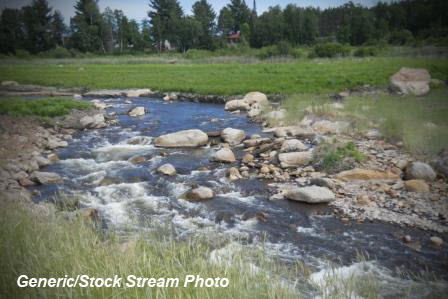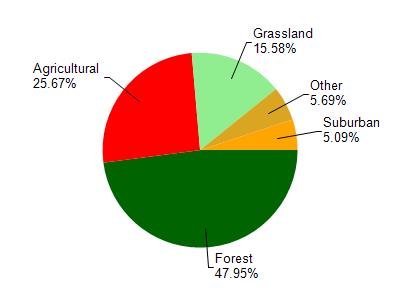
8.27 Miles
2.83 - 11.10
Cool-Cold Mainstem, Cool-Cold Headwater, Coldwater
2023
Good
La Crosse
Yes
Yes
No
Fish and Aquatic Life
Overview
Dutch Creek is a spring-fed stream located in east central La Crosse County. It flows in a northwesterly direction for approximately 9.4 miles before reaching the La Crosse River at Bangor. Dutch Creek has a gradient of approximately 30 feet per mile and drains steep forested hillsides and valley agricultural land. Dutch Creek is a Class II trout stream for its entire length.
The most recent habitat survey, completed in 1976, documented cool, clear water with a bottom consisting mainly of sand, rubble and gravel, with lesser amounts of silt, marl, boulder and detritus. Riparian land consisted of swamp hardwoods, shrub marsh and pasture. Heavy bank erosion was evident due to high water and overgrazing. In the lower half of Dutch Creek, in-stream cover was scarce consisting of scattered log tangles and over-hanging grasses. Upstream of STH 162, in-stream cover consisted mainly of undercut banks, log and brush tangles and scattered beds of aquatic vegetation. A fish and habitat survey of Dutch Creek should be conducted to update the 1976 survey information
Figure 26. Dutch Creek with barnyard adjacent to streambank.
The La Crosse County Land Conservation Department has operated a continuous water quality monitoring station since 1995 in Dutch Creek. The purpose was to monitor changes in the water chemistry of Dutch Creek in response to the installation of best management practices on farms upstream of this monitoring station. The goal of the project was to reduce sediment and nutrient loads to the La Crosse River and ultimately Lake Neshonoc. La Crosse County plans to continue operation of the monitoring station to assess the success of the Dutch Creek project and serve as a water quality baseline representative of similar sized La Crosse County streams.
In 1998, the La Crosse County Land Conservation Department initiated water chemistry testing of streams throughout La Crosse County. Baseflow conditions were targeted for testing as the most likely to show normal water quality conditions. Land Conservation staff sample streams four times annually when no rainfall or snowmelt has occurred during the previous 72 hours. Dutch Creek is sampled in two different locations: near the mouth and approximately five miles upstream from its mouth. Between 1998 and 2001 at the middle sample location, Dutch Creek met the county phosphorus goal in nearly 60% and met the county fecal coliform bacteria goal in 60% of the samples taken. At the lower sample location, Dutch Creek met the county phosphorus goal in nearly 40% and the county fecal coliform bacteria goal in approximatley 50% of the samples taken. These data indicate a nutrient load that is likely also contributing to high bacterial counts. The county ranks Dutch Creek among the top 50% of priority streams in the county on which to expend effort to reduce phosphorus and bacterial contamination.
From 1960 to 1983, Dutch Creek was strictly stocked with brown trout; however, since 1983 a combination of brook, brown and occasionally rainbow trout have been stocked. Access is possible from several road crossings and DNR owned easements.
Date 2002
Author Aquatic Biologist
Condition
Wisconsin has over 84,000 miles of streams, 15,000 lakes and milllions of acres of wetlands. Assessing the condition of this vast amount of water is challenging. The state's water monitoring program uses a media-based, cross-program approach to analyze water condition. An updated monitoring strategy (2015-2020) is now available. Compliance with Clean Water Act fishable, swimmable standards are located in the Executive Summary of Water Condition in 2018. See also the 'monitoring and projects' tab.
Reports
Management Goals
Wisconsin's Water Quality Standards provide qualitative and quantitative goals for waters that are protective of Fishable, Swimmable conditions [Learn more]. Waters that do not meet water quality standards are considered impaired and restoration actions are planned and carried out until the water is once again fishable and swimmable
Management goals can include creation or implementation of a Total Maximum Daily Load analysis, a Nine Key Element Plan, or other restoration work, education and outreach and more. If specific recommendations exist for this water, they will be displayed below online.
Monitoring
Monitoring the condition of a river, stream, or lake includes gathering physical, chemical, biological, and habitat data. Comprehensive studies often gather all these parameters in great detail, while lighter assessment events will involve sampling physical, chemical and biological data such as macroinvertebrates. Aquatic macroinvertebrates and fish communities integrate watershed or catchment condition, providing great insight into overall ecosystem health. Chemical and habitat parameters tell researchers more about human induced problems including contaminated runoff, point source dischargers, or habitat issues that foster or limit the potential of aquatic communities to thrive in a given area. Wisconsin's Water Monitoring Strategy was recenty updated.
Grants and Management Projects
Monitoring Projects
| WBIC | Official Waterbody Name | Station ID | Station Name | Earliest Fieldwork Date | Latest Fieldwork Date | View Station | View Data |
|---|
| 1654100 | Dutch Creek | 10013784 | Dutch Creek Station 4 - 75 Ft. Upstream From Darling Rd. Bridge | 4/17/1997 | 8/21/2013 | Map | Data |
| 1654100 | Dutch Creek | 10030754 | Dutch Creek - 2 M upstream of Cavadini Farm culvert | 11/12/2007 | 1/1/2015 | Map | Data |
| 1654100 | Dutch Creek | 10015421 | Dutch Creek Sta 5 - Private Rr to Freit Farm Betw. Hwy 162/Cth JB | | | Map | Data |
| 1654100 | Dutch Creek | 10015516 | Dutch Creek Station 6 - 100m Downstream Of Cth Jb Bridge In S36 | 7/3/2014 | 1/1/2015 | Map | Data |
| 1654100 | Dutch Creek | 10013934 | Dutch Creek - Hwy 162 Bridge In S35 | 1/1/2015 | 8/4/2015 | Map | Data |
| 1654100 | Dutch Creek | 10015913 | Dutch Creek - 20 Ft. Upstream From Bridge On Cthjb (Kaiser Site) | 4/17/1997 | 7/29/2014 | Map | Data |
| 1654100 | Dutch Creek | 10013783 | Dutch Creek Station 3 - 40 Ft. Upstream From Schroeder Rd. Bridge | | | Map | Data |
| 1654100 | Dutch Creek | 10013785 | Dutch Creek Station 5 - 1000 Ft. Downstream From Sth 162 Bridge | | | Map | Data |
| 1654100 | Dutch Creek | 10029576 | Dutch Creek at Hwy 11 | 1/1/2015 | 1/1/2015 | Map | Data |
| 1654100 | Dutch Creek | 10013940 | Dutch Creek Station 2 - Farm Road Bridge Crossing In S27 Se 14/ Se 1/4 | | | Map | Data |
| 1654100 | Dutch Creek | 10013935 | Dutch Creek Station 9 - Farm Rd. Bridge Crossing In S35 | | | Map | Data |
| 1654100 | Dutch Creek | 10013938 | Dutch Creek Station 9 - Cth JB | | | Map | Data |
| 1654100 | Dutch Creek | 323094 | Dutch Creek at Russlan Coulee Rd | 4/12/1994 | 8/29/2023 | Map | Data |
| 1654100 | Dutch Creek | 10013932 | Dutch Creek Station 6 - Coleman Rd. Bridge Crossing | 1/1/2015 | 1/1/2015 | Map | Data |
| 1654100 | Dutch Creek | 10013933 | Dutch Creek Station 7 - T16n R5w S27 Ne 1/4 Nw 1/4 | 1/1/2015 | 1/1/2015 | Map | Data |
| 1654100 | Dutch Creek | 10013937 | Dutch Creek Station 8 - 600 Ft Downstream Of Farm Road Crossing In S35 | | | Map | Data |
| 1654100 | Dutch Creek | 10015420 | Dutch Creek Station 4 - Confluence With Creek 35-9 | | | Map | Data |
| 1654100 | Dutch Creek | 10013939 | Dutch Creek Station 1 - 2200ft Downstream Of Farm Road Crossing In S27 | | | Map | Data |
| 1654100 | Dutch Creek | 10013936 | Dutch Creek Station 7 - 600 Ft Downstream Of Hwy 162 Bridge In S35 | | | Map | Data |
|

Watershed Characteristics
Dutch Creek is located in the Little La Crosse River watershed which is 240.79 mi². Land use in the watershed is primarily forest (48%), agricultural (25.70%) and a mix of grassland (15.60%) and other uses (10.80%). This watershed has 445.88 stream miles, 114.59 lake acres and 5,439.88 wetland acres.
Nonpoint Source Characteristics
This watershed is ranked High for runoff impacts on streams, Not Ranked for runoff impacts on lakes and Low for runoff impacts on groundwater and therefore has an overall rank of Low. This value can be used in ranking the watershed or individual waterbodies for grant funding under state and county programs.However, all waters are affected by diffuse pollutant sources regardless of initial water quality. Applications for specific runoff projects under state or county grant programs may be pursued. For more information, go to surface water program grants.
Dutch Creek is considered a Cool-Cold Mainstem, Cool-Cold Headwater, Coldwater under the state's Natural Community Determinations.
Natural communities (stream and lake natural communities) represent model results and DNR staff valiation processes that confirm or update predicted conditions based on flow and temperature modeling from historic and current landscape features and related variables. Predicated flow and temperatures for waters are associated predicated fish assemblages (communities). Biologists evaluate the model results against current survey data to determine if the modeled results are corect and whether biological indicators show water quaity degradation. This analysis is a core component of the state's resource management framework. Wisconsin's Riverine Natural Communities.
Cool (Cold-Transition) Mainstem streams are moderate-to-large but still wadeable perennial streams with cold to cool summer temperatures. Coldwater fishes are common to uncommon, transitional fishes are abundant to common, and warm water fishes are uncommon to absent. Headwater species are common to absent,
mainstem species are abundant to common, and river species are common to absent.
Cool (Cold-Transition) Headwaters are small, usually perennial streams with cold to cool summer temperatures. Coldwater fishes are common to uncommon (<10 per 100 m), transitional fishes are abundant to common, and warm water fishes are uncommon to absent. Headwater species are abundant to common, mainstem species are common to absent, and river species are absent.